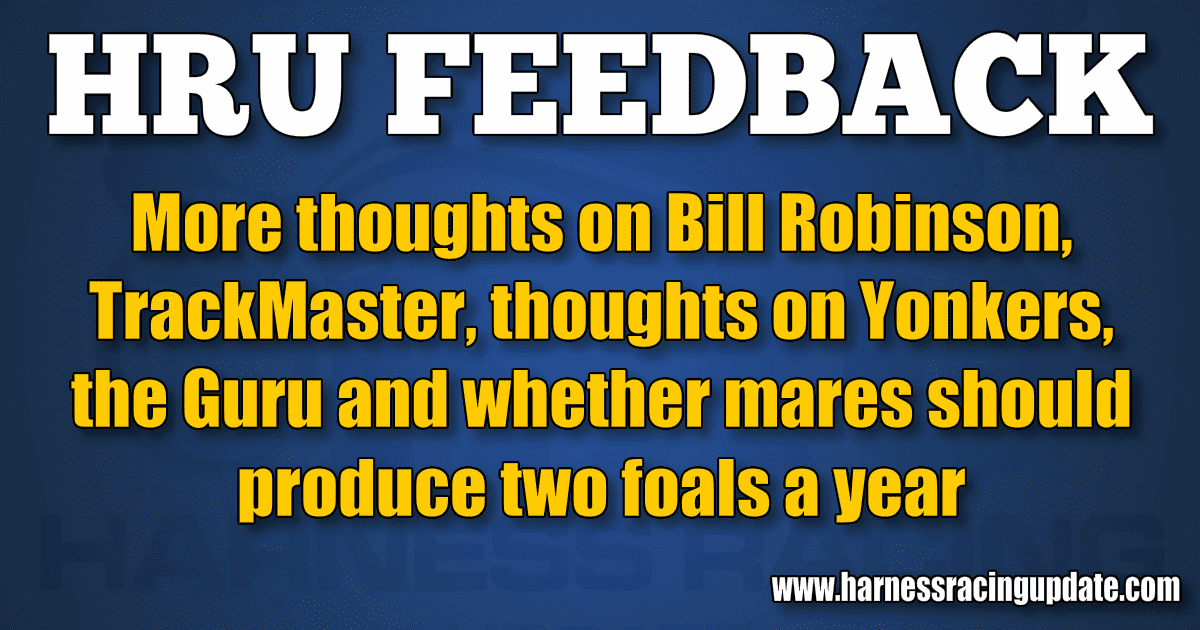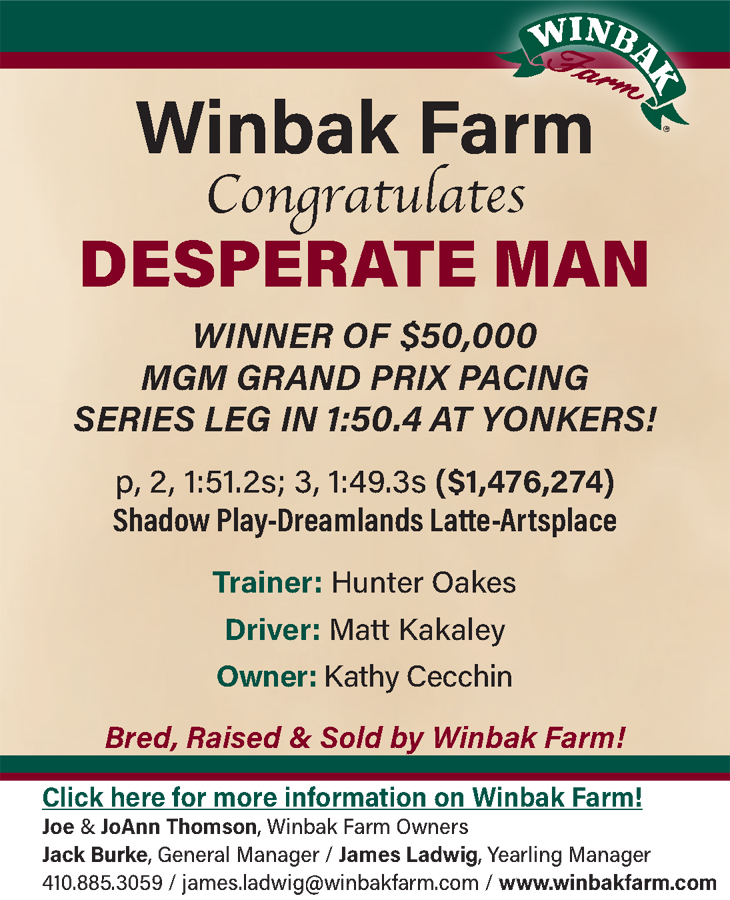HRU Feedback (2019-03-31)
Cdn Hall of Fame responds to column on Bill Robinson
Further to the article published in the Friday, March 29 issue of Harness Racing Update, (full story here), the Canadian Horse Racing Hall of Fame wishes to stress that the Hall takes the integrity of the horse racing industry, its participants, and its members, very seriously.
The rules of induction to the Hall contain a clause relating to the integrity of those nominated and elected.
The policy reads as follows:
At the discretion of the Nominating Committee and Election Committee of the relevant breed, entry to the Canadian Horse Racing Hall of Fame as an honored member will not be considered for anyone who has engaged in misconduct considered to be detrimental to the best interests of the Canadian Horse Racing Hall of Fame, its members, and the racing community in general.
In the interest of ensuring the highest level of oversight and transparency, the responsibility of evaluating, assessing and determining the suitability of candidates is left to the eight-person Thoroughbred and Standardbred Nominating Committees and the 20-person Thoroughbred and Standardbred Election Committees.
The Board of Directors annually reviews the Committees to ensure they are composed of “persons whose prestige, judgment and integrity are most likely to ensure the fair and impartial assessment of the qualities of the candidates submitted for their consideration and to ensure the maintenance of a high standard of excellence in the selections made by them.”
In addition, an accompanying clause also exists for the removal of a member of the Hall, stated as follows:
Any Honored Member may be removed from the Canadian Horse Racing Hall of Fame at the discretion of the Nominating Committee and Election Committee for misconduct considered to be detrimental to the best interests of the Canadian Horse Racing Hall of Fame, its members, and the racing community in general. The Directors of the Canadian Horse Racing Hall of Fame or any member of the racing community or general public may make a recommendation for an Honored Member to be removed from the Canadian Horse Racing Hall of Fame. The recommendation will be reviewed by the Nominating Committee of the relevant breed. If the vote to remove the Honored Member is 75% or higher, the Nominating Committee of the relevant breed shall recommend the removal of the Honored Member. If the vote is less than 75%, then the recommendation shall be dismissed. If a Nominating Committee removal recommendation is made, then the Election Committee shall review the recommendation. 15 of the 20 members of the Election Committee (75%) must agree to the removal of the Honored Member from the Canadian Horse Racing Hall of Fame for the Honored Member to be removed. Should a subsequent application for appeal be filed, the decision of the Canadian Horse Racing Hall of Fame Advisory Board will be final.
The Canadian Horse Racing Hall of Fame has ensured that its voters are aware of the regulations pertaining to the election of candidates. It is ultimately the decision of the voters to evaluate each candidate based on these regulations.
— Darryl Kaplan / president, Canadian Horse Racing Hall of Fame
More on Robinson
After reading Andrew Cohen’s front page story in the March 29 HRU, a tremendous amount of anger came over me with regards to Bill Robinson being nominated. How could Robinson even be on the nomination list after all of his suspensions and infractions? I have continually harped here in Feedback how I don’t believe AGCO have been doing a proper job and needs a complete overhaul, those in charge have become too complacent and seem to have adopted the attitude that the cheaters have had too much of a head start and there is no use to try and stop it only try to control it.
The Hall of Fame is the pinnacle of achievement in the sport, and in my opinion, even to get on the nomination list should be just as hard as trying to obtain a personal concealed weapon license.
A few years back, someone overheard a conversation I was having with a horseman and interrupted us and said he totally agreed with my tough point of view on how to deal with cheaters and said this is what the sport needs. The problem in my view in Ontario has been no one truly appreciates the fact their game is broken and all of their individual attempts to bring fans to their tracks just conceals the true problem which is not an All For One industry it’s always been One For All industry which it has become now with WEG controlling all the strings. Maybe I should do something about this, seems like I have some backers.
— Bob Adams / London, ON
In defence of Robinson
I am sorry Bill Robinson was again nominated to be inducted into the Canadian Horse Racing Hall of Fame, only to be bashed by the likes of Andrew Cohen.
I am also sorry the case against was brought forth by this eloquent scribe, a man who has editorialized on everything from John F Kennedy’s greatest speech, to making a case that he (Cohen) be made commissioner of all North American harness racing.
Mr. Cohen admits the man he nominated was not perfect, but that was okay.
Mr. Cohen built his case by referencing conversations with known detractors of Robinson. As a well-known journalist, I can see why he didn’t research the other side, because it didn’t fit his narrative, something quite familiar in this modern day of journalism.
The fact of the matter is, Bill Robinson was the most dominant trainer of his time.
The mandate of the HOF is to “recognize major achievements and contributions to Canadian horse racing.”
I don’t know who nominated Bill Robinson, but until he gets in, it is becoming a cruel joke.
— Marty Adler / Amhertsburg, ON
The dark age of data
Dean Towers was correct when wrote in a recent HRU post, “Accurate information is key in the new wagering age,” (full story here), but only touched the surface of the data dark age.
TrackMaster has a long standing exclusive data arrangement with the US Trotting Association as the sole data provider.
The arrangement grants this third party organization the authority to make all data decisions for a billion-dollar betting business. And to their credit, TrackMaster has kept a tight squeeze on the business, but at what cost to the industry?
The immediate cost that comes to mind is the lack of CRWs’ participation in harness betting pools. Computerized Robotic Wagering (CRW) companies represent a quarter of all thoroughbred bets or +$2.5 billion in handle.
These betting syndicates pay thoroughbred data suppliers for access to electronic data feeds that power their computer models. These data rich formats also power Performance Ratings as seen in the Ragozin Sheets and speed figures producers like DRF’s Beyer Speed Figure and Brisnet’s Speed Ratings as well as innovated analytics models, similar to those driving millennials into sports betting.
The non-existence of these performance and speed figure producers in harness racing along with lack of participation from CRWs in harness betting pools are influenced by TrackMaster’s data exclusivity.
But TrackMaster is not solely responsible for harness racing’s dark age of data… No, they were granted this right by the USTA.
A horseman, who is fully invested in the business said it best to me, “the USA has deprived its core constituents millions of dollars in revenue (from increased betting handle) by preventing bettors access and information they need from our data. Rather than look at the deeper issue, the USTA continues its bureaucratic relationship with TrackMaster and without a care of the damage it’s doing to our business.”
— Daniel Zucker / New York
USTA responds to Zucker
In his Letter to the Editor, “The dark age of data,” Daniel Zucker’s presentation of the facts is incredibly inaccurate.
First, he states that “TrackMaster has a long standing exclusive data arrangement with the US Trotting Association as the sole data provider. The arrangement grants this third party organization the authority to make all data decisions for a billion-dollar betting business.”
Wrong.
The partnership not only includes TrackMaster and the USTA, but Daily Racing Form too. In addition, TrackMaster’s exclusivity is only for electronic, not printed information and is limited to only handicapping data, not any of the USTA’s other information, which also includes a vast amount of statistics on breeding, records and harness racing history.
But Zucker’s next assertion is even worse.
He concludes that his mistaken first premise is the reason that, “The immediate cost that comes to mind is the lack of CRWs’ participation in harness betting pools. Computerized Robotic Wagering (CRW) companies represent a quarter of all thoroughbred bets or +$2.5 billion in handle. These betting syndicates pay thoroughbred data suppliers for access to electronic data feeds that power their computer models.”
The reality is that CRWs do license data from TrackMaster.
“From our perspective, we want to facilitate the sale of data to CRWs and we do. In fact, many purchase harness data from us,” is what TrackMaster President and CEO David Siegel explained.
It’s pretty much common knowledge that CRW groups – or “cartels,” as they occasionally have been called – are diving into harness racing pools across the country on a daily basis.
Zucker’s third point that harness racing handicapping information lacks speed figures and performance ratings, clearly indicates that he hasn’t taken a look at TrackMaster past performances, which contain speed and class ratings, or Daily Racing Form’s Harness Eye.
“Zucker implies that performance ratings don’t exist in harness racing,” said Siegel. “Nothing could be further than the truth — TrackMaster has them in all of our past performances and Daily Racing Form does their own in Harness Eye. They are in virtually all printed simulcast programs supplied by Incompass Solutions to more than 800 outlets.”
But now let’s consider some facts that are real.
TrackMaster has worked in cooperation with the USTA to provide valuable, free information that benefits bettors and racetracks.
First, TrackMaster provides free past performances for the USTA’s Strategic Wagering program that has proven to increase handle, which is why 19 different racetracks participated in the program in 2018. Last year, $28.6 million was wagered through Strategic Wagering.
They also made free past performances available for USTA online handicapping contests that increased entries into the World Harness Handicapping Championship.
TrackMaster also provides a free virtual stable to track individual horses.
For racetracks, TrackMaster offers an automated morning line at no charge as well as a free data packages to USTA member racetracks. That package includes:
• StatsMaster – handicapping stats for drivers, trainers and horses and “angles” that include information for all starts, off-tracks, as favorite or longshot
• Off To The Races – easy to understand information and stats for the novice handicapper or large groups that include wagering selection and advice geared toward increasing the chances of cashing a winning ticket.
• Complimentary Electronic PPs – provides racetracks the ability to give a limited number of best customers web access to complimentary TrackMaster past performances
Ironically, a visit to Zucker’s website reveals that he offers to sell you his own Pace Figures and Form Cycle Pattern Analysis handicapping subscriptions for $9.95 per card, $19.95 per day, $29.95 per weekend and $899.95 for the year, essentially putting him in the same business – albeit on the thoroughbred side and at a considerably higher price – as TrackMaster and Daily Racing Form.
In closing, we’re reminded of another Daniel from New York, the late U.S. Senator Moynihan, who is famously remembered for stipulating that everyone is entitled to their own opinion, but not his own facts. We concur.
— Dan Leary / USTA director of marketing and communications
Reply to Dan Gall’s letter
In response to Dan Gall and his comments March 24 HRU (full story here): Why would as you called them your partners at WEG request that the information was no longer required? When I sat down with Jamie Martin at his WEG office and showed and explained numerous examples of the importance and how the serious handicapper would now have a fuller picture of prior races that when he watched replays his handicapping would benefit from the added information. If they did in fact put it in as Dan Gall says, they work with all of their harness partners and tracks then why would WEG who requested it then say to take it out, it wasn’t needed. By that time I was gone as a customer, because my meeting was in March 2009 at WEG, and as Dan said they started in 2010 to 2013 which coincides with the reply when I called SC and was told it was too much trouble they didn’t start putting the information in until one year later. In addition I did a follow up with Mr. Martin with the initial reply I received about it being too much trouble and he reiterated that on their side they would keep pursuing it with SC. I still have all my notes on my meetings along with my presentation.
— Bob Adams / London, ON
Not impressed with Sagamore Hill final
Watching the Sagamore final on Tuesday (March 27) at Yonkers looked like throwback to the type of bush-league racing from the ‘80s. The coupled entry repeatedly pushed the competition high and low numerous times to soften it up for his closing pari-mutuel partner. This is not acceptable in any type of professional racing whether it’s in thoroughbreds or harness racing. What makes this even worse is the blind eye given this behavior by the judging oversight crew. This sends a message to other drivers at other tracks that this is acceptable behavior and there goes the advances in integrity that we’ve seen from this sport in recent years. It is my belief that the in-action by the Yonkers crew has hurt us all. Without adherence to rules then what we’re left with is the harness racing equivalent of professional wrestling.
— David Perry / Dearborn, MI
Yonkers can learn from Ontario
I just want to vent at how frustrated I am at the lack of any change at Yonkers under the new management during the past year. I have been betting the races for close to 50 years, and I think it’s worse today than at any time. Every night you see drivers pulling back to let horses drop in front of them before the first quarter. More often than not, that horse will finish ahead of them at the wire, usually beating me out of the tri or super. By closing the hole, and forcing the outside horse to go on, or pull to the back, changes the outcome of the race. Officials seem convinced there is nothing they can do.
Well, just in the past couple weeks, Mohawk have fined or suspended drivers trying to get better racing.
Chris Christoforou — Driving in an Unsatisfactory manner. His 8-5 race favorite made no attempt.
Kelly Hoert — Going a slow quarter. (This should be enforced every night at Yonkers)
Brad Harris — Allowing a horse to pass needlessly on the inside.
Doug McNair — Interference. I don’t think I’ve seen a worse interference than Dr. J in the first heat of the Graduate, forcing his way back into the three-hole almost knocking the horse behind him off his feet.
These are just examples of what Yonkers and the other tracks should be looking at.
— Darcy Mann / Toronto, ON
Gurfein’s take is “laughable”
Reading Ron Gurfein’s opinion on purse structure is laughable (full story here) Why reward a field of maidens or NW/2 with a hefty purse? Those races at most tracks are the most non-competitive races on the card, where half the field wants to fall down and the interests of the other half are attempting to “educate” their horses. It adds up to a race where gamblers should not and do not wager like they do with a competitive claiming or aged condition race. Classes that bring in the most handle should be rewarded with the highest purses, since purses are generated by handle.
However, I wouldn’t expect someone like Ron Gurfein to agree publicly, as he bends over backward to kiss the butts of breeders and yearling owners as to not lose his spot on some South Florida deck of egomaniacs. He is part of the crumpet eating, deck watching, T-Bred envious group of breeders and yearling owners who want a huge increase in purses for maidens similar to the T-Bred business, so that investments are recouped early in a horse’s career and ultimately drive up prices of yearlings and price out the small time buyer.
Remember, small timers aren’t invited to this magical deck. Why do you think every year you see the same breeders and owners in the winner’s circle at all the major races? In my opinion, the opposite should occur. Maiden and NW/2-5 races should have the lowest purses for two main reasons. Firstly, there is lower handle for those conditions and secondly, the lower purses would increase the sense of urgency to win out of those classes and start racing for better purses. Shouldn’t you have to earn your right by winning to race for better purses?
— Mike Campbell / Milford, PA
Cherry: We should allow mares two foals per year
We have what is commonly known as a horse shortage in harness racing, which is really just an imbalance based on number of race days a racetrack would like to run a year and the horses available for those tasks.
Obviously, the Southern Hemisphere loves this since many of the horse’s names end with an A or an N. But I am not telling you anything you don’t already know.
One partial solution to the horse shortage is to allow broodmares to have two foals a year. Originally nature didn’t allow for that, but due to technology this can now be accomplished with embryo transplant (ET).
The first result is obvious that we would have more foals a year. It would also be a safety net for the breeders since they might not get quite the same price as they would for one foal if it was perfect, but how many foals are really born perfect? This does not take account of the double digits of mares that are barren or miscarry per year.
This gives two chances and makes the breeding portion safer. It also would allow stallions to breed more making it more economic for stallion owners. It also would not hurt the genetic pool since the rule would only allow mares to be bred to one stallion per year so, the ratios of genetic diversity would basically remain the same.
I would submit this new rule as a five-year experiment since nobody likes change and this will give the feel and the reality of it being temporary so it could be evaluated in the future. But the best by-product is that the rule would state that all the ET’s would have to be done with only Standardbred recipients.
This would help possibly 1,000 mares that are up for adoption and looking for homes, so they don’t end up in the slaughterhouse and to have a role going forward. Due to the expensive nature of performing ET this rule would allow the gene pool to breed more of the top mares since it would not be economically feasible to do it with every run-of-the-mill female that retired.
If anyone reading this has any further ideas or enhancements or criticisms, I would like to address them now before I send this rule change in play in August when the changes are due.
— Eric Cherry / Boca Raton, FL

















